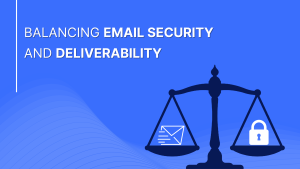Warum die E-Mail-Überprüfung in Echtzeit wichtig ist

E-Mails sind ein grundlegender Bestandteil der persönlichen und beruflichen Kommunikation, so dass Genauigkeit, Sicherheit und Zuverlässigkeit entscheidend sind. Eine effektive Möglichkeit, dies zu erreichen, ist die synchrone Überprüfung. Hier erfahren Sie, warum eine synchrone oder Echtzeit-Überprüfung für E-Mails unerlässlich ist:
Konsistenz und Verlässlichkeit
Die synchrone Überprüfung stellt sicher, dass alle Aspekte einer E-Mail – wie die Authentizität des Absenders, die Integrität des Inhalts und die Empfängeradressen – gleichzeitig überprüft werden. Dieser Prozess garantiert, dass jedes E-Mail-Element konsistent und zuverlässig ist, wodurch das Risiko von nicht zugestellten oder fehlgeleiteten E-Mails verringert wird. Es stellt sicher, dass E-Mails die beabsichtigten Empfänger ohne Fehler erreichen.
Fehlererkennung in Echtzeit
Mit der synchronen Überprüfung werden alle Probleme oder Fehler in einer E-Mail in Echtzeit erkannt. Dieses unmittelbare Feedback ermöglicht es Absendern, Fehler zu korrigieren, bevor die E-Mail versendet wird, und stellt sicher, dass die Nachricht korrekt und vollständig ist. Wenn zum Beispiel eine E-Mail-Adresse falsch eingegeben wurde, kann die synchrone Überprüfung den Absender sofort alarmieren und so eine fehlgeschlagene Zustellung verhindern.
Genießen Sie präzisere Daten
Metriken zur E-Mail-Beteiligung sind wichtig, um Ihre E-Mails und Ihre Versandstrategie zu optimieren und die Zustellbarkeit zu überwachen – aber nicht, wenn sie ungenau sind. Wenn Sie Ihre E-Mail-Liste mit einer Echtzeit-Überprüfung sauber halten, können Sie genauere Daten nutzen.
Ungültige E-Mails verfälschen die Daten, indem sie Ihre Engagement-Metriken viel niedriger erscheinen lassen, als sie tatsächlich sind. Wenn Sie beispielsweise eine E-Mail an 100 Personen senden und 50 Personen darauf klicken, liegt Ihre Klickrate bei 50%. Wenn jedoch 25 dieser 100 Empfänger ungültig sind, bedeutet dies, dass die Gesamtzahl der Empfänger in Wirklichkeit 75 und nicht 100 beträgt. Ihre Klickrate würde also 66% betragen. Ergebnisse, die Sie vielleicht auf schlechte Inhalte oder ein schlechtes Design zurückführen, können in Wirklichkeit auf ungültige E-Mails zurückzuführen sein.
Steigern Sie Engagement und Konversionen
Engagement-Metriken wie Klicks, Weiterleitungen und Öffnungsraten helfen Internetdienstleistern festzustellen, ob Sie die besten Praktiken für Ihren Inhalt und Ihre E-Mail-Liste befolgen. Eine geringe Beteiligung deutet darauf hin, dass Ihre Empfänger entweder nicht an Ihren Nachrichten interessiert sind oder dass Ihre E-Mail-Liste viele ungültige Adressen enthält. Umgekehrt deuten hohe Engagement-Raten darauf hin, dass Sie E-Mails an eine gültige Liste von Empfängern senden, die an Ihren Inhalten interessiert sind.
Eine saubere E-Mail-Liste hilft Ihnen, den Spam-Ordner zu vermeiden, mehr E-Mails zuzustellen und das Engagement zu erhöhen. Je sauberer Ihre E-Mail-Liste ist, desto höher ist die Zustellbarkeit, so dass Sie mehr echte Empfänger erreichen können. In Verbindung mit höheren Engagement-Raten führt dies natürlich zu höheren Konversionsraten.
Verbesserte Sicherheit
E-Mail-Sicherheit ist das A und O, um Phishing, Spam und andere bösartige Aktivitäten zu verhindern. Die synchrone Überprüfung spielt dabei eine entscheidende Rolle, da sie die Authentizität des Absenders und die Integrität des E-Mail-Inhalts in Echtzeit überprüft. So wird sichergestellt, dass E-Mails während der Übertragung nicht manipuliert werden und dass die Empfänger der Quelle der E-Mail vertrauen können.
Verbesserte Koordinierung
In einem geschäftlichen Umfeld ist eine effektive Kommunikation zwischen den Teammitgliedern entscheidend. Die synchrone Überprüfung stellt sicher, dass die gesamte E-Mail-Kommunikation abgestimmt und korrekt ist, was zu einer besseren Koordination beiträgt. Wenn Sie beispielsweise Besprechungen planen oder wichtige Aktualisierungen weitergeben, garantiert die synchrone Überprüfung, dass alle Empfänger gleichzeitig die gleichen, genauen Informationen erhalten.
Effizienz und Produktivität
Die synchrone Überprüfung steigert die Effizienz der E-Mail-Kommunikation, da weniger Nachfassaktionen und Korrekturen erforderlich sind. Durch die synchrone Überprüfung von E-Mails wird das Risiko von Fehlern und Missverständnissen minimiert. Dies führt zu effizienteren Arbeitsabläufen und höherer Produktivität, da sich die Teams auf ihre Aufgaben konzentrieren können, ohne sich um E-Mail-Probleme zu kümmern.
Sparen Sie bei den Sendekosten
Die synchrone Überprüfung stellt sicher, dass E-Mails von Anfang an korrekt und sicher sind und optimiert so die Ressourcennutzung. Sie reduziert den Zeit- und Arbeitsaufwand für die Behebung von E-Mail-Problemen und das erneute Versenden von Nachrichten. Diese effiziente Nutzung von Ressourcen führt zu Kosteneinsparungen und effektiveren Kommunikationsstrategien.
Höhere Qualität der Kommunikation
Letztlich führt die synchrone Überprüfung zu einer höheren Qualität der E-Mail-Kommunikation. Ganz gleich, ob es sich um Marketingkampagnen, Kundensupport oder interne Kommunikation handelt: Wenn Sie sicherstellen, dass E-Mails korrekt, sicher und zuverlässig sind, verbessert sich die Qualität der Interaktionen insgesamt. Dies führt zu einer besseren Kundenerfahrung, einer besseren Zusammenarbeit im Team und einem professionelleren Image.
Fazit
Die synchrone oder Echtzeit-Überprüfung ist ein wichtiges Verfahren, um die Integrität und Effektivität der E-Mail-Kommunikation zu gewährleisten. Durch die Erkennung von Fehlern in Echtzeit, die Verbesserung der Sicherheit und die Förderung der Konsistenz spielt sie eine entscheidende Rolle bei der Aufrechterhaltung der Zuverlässigkeit von E-Mails. In einer Welt, in der die E-Mail ein primäres Kommunikationsmittel ist, ist die synchrone Verifizierung nicht nur eine bewährte Praxis, sondern eine Notwendigkeit für hochwertige, sichere und effiziente E-Mail-Interaktionen, die letztlich zu einem stärkeren Vertrauen in digitale Interaktionen führen.
Zugang zur E-Mail-Überprüfung in Echtzeit




